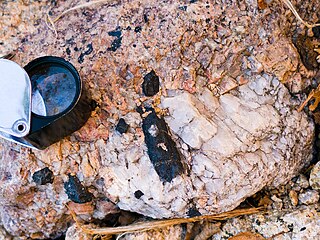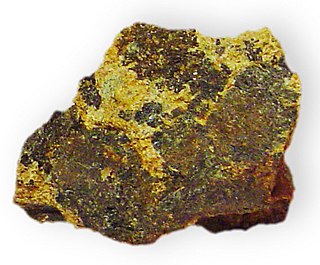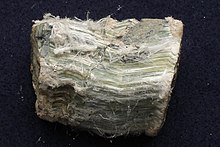
Talc, or talcum, is a clay mineral composed of hydrated magnesium silicate, with the chemical formula Mg3Si4O10(OH)2. Talc in powdered form, often combined with corn starch, is used as baby powder. This mineral is used as a thickening agent and lubricant. It is an ingredient in ceramics, paints, and roofing material. It is a main ingredient in many cosmetics. It occurs as foliated to fibrous masses, and in an exceptionally rare crystal form. It has a perfect basal cleavage and an uneven flat fracture, and it is foliated with a two-dimensional platy form.

Amphibole is a group of inosilicate minerals, forming prism or needlelike crystals, composed of double chain SiO
4 tetrahedra, linked at the vertices and generally containing ions of iron and/or magnesium in their structures. Its IMA symbol is Amp. Amphiboles can be green, black, colorless, white, yellow, blue, or brown. The International Mineralogical Association currently classifies amphiboles as a mineral supergroup, within which are two groups and several subgroups.

Actinolite is an amphibole silicate mineral with the chemical formula Ca2(Mg4.5–2.5Fe2+0.5–2.5)Si8O22(OH)2.

Tiger's eye is a chatoyant gemstone that is usually a metamorphic rock with a golden to red-brown colour and a silky lustre. As members of the quartz group, tiger's eye and the related blue-coloured mineral hawk's eye gain their silky, lustrous appearance from the parallel intergrowth of quartz crystals and altered amphibole fibres that have mostly turned into limonite.

Mesothelioma is a type of cancer that develops from the thin layer of tissue that covers many of the internal organs. The area most commonly affected is the lining of the lungs and chest wall. Less commonly the lining of the abdomen and rarely the sac surrounding the heart, or the sac surrounding the testis may be affected. Signs and symptoms of mesothelioma may include shortness of breath due to fluid around the lung, a swollen abdomen, chest wall pain, cough, feeling tired, and weight loss. These symptoms typically come on slowly.

Serpentine subgroup are greenish, brownish, or spotted minerals commonly found in serpentinite. They are used as a source of magnesium and asbestos, and as decorative stone. The name comes from the greenish color and smooth or scaly appearance from the Latin serpentinus, meaning "snake-like".

Tremolite is a member of the amphibole group of silicate minerals with composition Ca2(Mg5.0-4.5Fe2+0.0-0.5)Si8O22(OH)2. Tremolite forms by metamorphism of sediments rich in dolomite and quartz, and occurs in two distinct forms, crystals and fibers. Tremolite forms a series with actinolite and ferro-actinolite. Pure magnesium tremolite is creamy white, but the color grades to dark green with increasing iron content. It has a hardness on Mohs scale of 5 to 6. Nephrite, one of the two minerals known as the gemstone jade, is a green crystalline variety of tremolite.

Diopside is a monoclinic pyroxene mineral with composition MgCaSi
2O
6. It forms complete solid solution series with hedenbergite and augite, and partial solid solutions with orthopyroxene and pigeonite. It forms variably colored, but typically dull green crystals in the monoclinic prismatic class. It has two distinct prismatic cleavages at 87 and 93° typical of the pyroxene series. It has a Mohs hardness of six, a Vickers hardness of 7.7 GPa at a load of 0.98 N, and a specific gravity of 3.25 to 3.55. It is transparent to translucent with indices of refraction of nα=1.663–1.699, nβ=1.671–1.705, and nγ=1.693–1.728. The optic angle is 58° to 63°.

Riebeckite is a sodium-rich member of the amphibole group of silicate minerals, chemical formula Na2(Fe2+3Fe3+2)Si8O22(OH)2. It forms a solid solution series with magnesioriebeckite. It crystallizes in the monoclinic system, usually as long prismatic crystals showing a diamond-shaped cross section, but also in fibrous, bladed, acicular, columnar, and radiating forms. Its Mohs hardness is 5.0–6.0, and its specific gravity is 3.0–3.4. Cleavage is perfect, two directions in the shape of a diamond; fracture is uneven, splintery. It is often translucent to nearly opaque.

Cummingtonite is a metamorphic amphibole with the chemical composition (Mg,Fe2+
)
2(Mg,Fe2+
)
5Si
8O
22(OH)
2, magnesium iron silicate hydroxide.

Serpentinization is a hydration and metamorphic transformation of ferromagnesian minerals, such as olivine and pyroxene, in mafic and ultramafic rock to produce serpentinite. Minerals formed by serpentinization include the serpentine group minerals, brucite, talc, Ni-Fe alloys, and magnetite. The mineral alteration is particularly important at the sea floor at tectonic plate boundaries.

Serpentine soil is an uncommon soil type produced by weathered ultramafic rock such as peridotite and its metamorphic derivatives such as serpentinite. More precisely, serpentine soil contains minerals of the serpentine subgroup, especially antigorite, lizardite, and chrysotile or white asbestos, all of which are commonly found in ultramafic rocks. The term "serpentine" is commonly used to refer to both the soil type and the mineral group which forms its parent materials.
Asbestiform is a crystal habit. It describes a mineral that grows in a fibrous aggregate of high tensile strength, flexible, long, and thin crystals that readily separate. The most common asbestiform mineral is chrysotile, commonly called "white asbestos", a magnesium phyllosilicate part of the serpentine group. Other asbestiform minerals include riebeckite, an amphibole whose fibrous form is known as crocidolite or "blue asbestos", and brown asbestos, a cummingtonite-grunerite solid solution series.
Occupational lung diseases comprise a broad group of diseases, including occupational asthma, industrial bronchitis, chronic obstructive pulmonary disease (COPD), bronchiolitis obliterans, inhalation injury, interstitial lung diseases, infections, lung cancer and mesothelioma. These can be caused directly or due to immunological response to an exposure to a variety of dusts, chemicals, proteins or organisms. Occupational cases of interstitial lung disease may be misdiagnosed as COPD, idiopathic pulmonary fibrosis, or a myriad of other diseases; leading to a delay in identification of the causative agent.

Asbestos is a naturally occurring fibrous silicate mineral. There are six types, all of which are composed of long and thin fibrous crystals, each fibre being composed of many microscopic "fibrils" that can be released into the atmosphere by abrasion and other processes. Inhalation of asbestos fibres can lead to various dangerous lung conditions, including mesothelioma, asbestosis, and lung cancer. As a result of these health effects, asbestos is considered a serious health and safety hazard.

Erionite is a naturally occurring fibrous mineral that belongs to a group of minerals called zeolites. It usually is found in volcanic ash that has been altered by weathering and ground water. Erionite forms brittle, wool-like fibrous masses in the hollows of rock formations and has an internal molecular structure similar to chabazite. Some properties of erionite are similar to the properties of asbestos; however, erionite is not currently regulated by the U.S. Environmental Protection Agency and there are no occupational exposure limits for erionite fibers. Erionite was first described by A.S. Eakle in 1898, as white woolly fibrous masses in cavities in rhyolite lava near Durkee, Oregon. It was originally thought to be another relatively rare zeolite named offretite, which is very similar to erionite in appearance and chemical composition.

Balangeroite is found in one of the most important chrysotile mines in Europe, the Balangero Serpentinite. Hence, it is usually mistaken as an asbestiform in an assemblage of other mineral phases like chrysotile, magnetite and Fe-Ni alloys. However, Balangeroite does not lead to serious health problems caused by asbestos fibers.

The Asbestos Mountains is a range of hills in the Northern Cape province of South Africa, stretching south-southwest from Kuruman, where the range is known as the Kuruman Hills, to Prieska. It passes Boetsap, Danielskuil, Lime Acres, Douglas and Griekwastad. The range lies about 150 kilometres (93 mi) west of Kimberley and rises from the Ghaap Plateau.

All types of asbestos fibers are known to cause serious health hazards in humans. The most common diseases associated with chronic exposure to asbestos are asbestosis and mesothelioma.




















